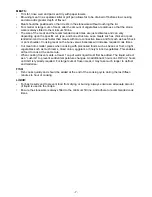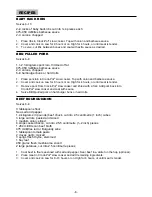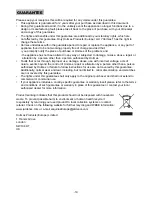
-6-
• ALWAYS turn your slow cooker off, unplug it from the electrical outlet, and allow it to cool before
cleaning.
• The lid and stoneware can be washed in the dishwasher or with hot, soapy water. Do not use
abrasive cleaning compounds or scouring pads. A cloth, sponge, or rubber spatula will usually
remove residue. To remove water spots and other stains, use a non-abrasive cleaner or vinegar.
• As with any fine ceramic, the stoneware and lid will not withstand sudden temperature changes.
Do not wash the stoneware or lid with cold water when they are hot.
• The outside of the heating base may be cleaned with a soft cloth and warm, soapy water. Wipe
dry. Do not use abrasive cleaners.
CAUTION:
Never immerse the heating base in water or other liquid.
• No other servicing should be performed.
NOTE:
After cleaning by hand allow pot to air dry before storing.
HINTS AND TIPS
HOW TO ClEAN yOUR SlOW COOKER
PASTA AND RICE:
• For best rice results, use long grain converted rice or a special rice as the recipe suggests. If
the rice is not cooked completely after the suggested time, add an extra 1 to 1½ cups of liquid
per cup of cooked rice and continue cooking for 20 to 30 minutes.
• For best pasta results, first partially cook the pasta in a pot of boiling water until just tender. Add
the pasta to the Crock-Pot
®
slow cooker during the last 30 minutes of cook time.
bEANS:
• Beans must be softened completely before combining with sugar and/or acidic foods. Sugar and
acid have a hardening effect on beans and will prevent softening.
• Dried beans, especially red kidney beans, should be boiled before adding to a recipe.
• Fully cooked canned beans may be used as a substitute for dried beans.
VEgETAbLES:
• Many vegetables benefit from slow cooking and are able to develop their full flavour. They tend
not to overcook in your slow cooker as they might in your oven or on your hob.
• When cooking recipes with vegetables and meat, place vegetables in slow cooker before meat.
Vegetables usually cook more slowly than meat in the slow cooker.
• Place vegetables near the sides or bottom of the stoneware to facilitate cooking.
HERbS AND SPICES:
• Fresh herbs add flavour and colour, but should be added at the end of the cooking cycle as the
flavour will dissipate over long cook times.
• Ground and/or dried herbs and spices work well in slow cooking and may be added at the
beginning.
• The flavour power of all herbs and spices can vary greatly depending on their particular strength
and shelf life. Use herbs sparingly, taste at end of cook cycle and adjust seasonings just before
serving.
MILK:
• Milk, cream, and sour cream break down during extended cooking. When possible, add during
the last 15 to 30 minutes of cooking.
• Condensed soups may be substituted for milk and can cook for extended times.
SOUPS:
• Some soup recipes call for large amounts of water. Add other soup ingredients to the slow
cooker first then add water only to cover. If thinner soup is desired, add more liquid at
serving time.
Содержание SCCPBPP605
Страница 13: ...notes 13 ...
































